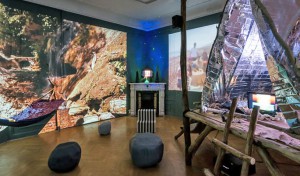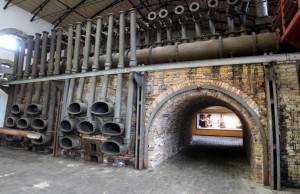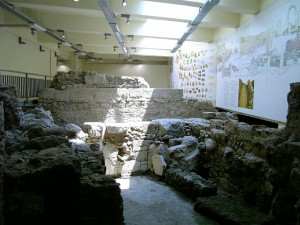The National Theatre on Agiou Konstantinou street, near the Omonia square, was built to meet the city’s need for a new theatre. Designed by Hernst Ziller and constructed from 1891 to 1901, the project was initiated by King Georg I.
Located on a small lot purchased by Bavarian courtesan, Thonn, private funding for its construction was supplied by a large number of wealthy Greek patrons, most of them from the diaspora; Rallis, Korgialenios and Evgenidis. Despite the challenges posed by the small size of the property and the extreme land gradient, the architect delivered a splendid building of the Eclectisistic order, a truly magnificent theatre, containing two full stages and a large lecture room. The National Theatre is admired by Greek and international audiences alike.
The National Theatre web site: www.n-t.gr
Source: www.athensattica.gr
 The Stathatos Manor in Kolonaki, is located at the junction of Vasilissis Sofias and Irodotou 1 streets, where it houses a wing of the Cycladic Art Museum. Built in the late 19th Century by famous architect, Hernst Ziller, the manor was based on plans drawn in 1895 for an expatriate merchant from Ithaca by the name of Stathatos, who, along with his wife, used the manor as their residence. During the 1930’s the building saw extensive alterations and a complete interior renovation.
The Stathatos Manor in Kolonaki, is located at the junction of Vasilissis Sofias and Irodotou 1 streets, where it houses a wing of the Cycladic Art Museum. Built in the late 19th Century by famous architect, Hernst Ziller, the manor was based on plans drawn in 1895 for an expatriate merchant from Ithaca by the name of Stathatos, who, along with his wife, used the manor as their residence. During the 1930’s the building saw extensive alterations and a complete interior renovation.
 After World War II it was used as an embassy, until 1981 when it became the property of the Hellenic State. The Government initially intended to convert the building into a guest-house for distinguished visitors, so the manor was again fully refurbished, this time being restored to its original design. It was eventually assigned to the Cycladic Art Museum.
After World War II it was used as an embassy, until 1981 when it became the property of the Hellenic State. The Government initially intended to convert the building into a guest-house for distinguished visitors, so the manor was again fully refurbished, this time being restored to its original design. It was eventually assigned to the Cycladic Art Museum.
Museum web site: www.cycladic.gr
Source: www.athensattica.gr
 The Athens Gasworks factory, or “Gazi” as most people call it, is on the right side of Pireos Street, immediately past the entrance to Iera Odos. Built around 1860, the first plant was quite small and was owned by businessman, Frangiskos Feraldis. The small plant expanded rapidly, becoming an immense industrial complex. And though its general design mirrored the same architectural principles seen in similar industrial buildings throughout Europe, modernist decorative elements were also present, some displayed on the huge metal frames of the structures.
The Athens Gasworks factory, or “Gazi” as most people call it, is on the right side of Pireos Street, immediately past the entrance to Iera Odos. Built around 1860, the first plant was quite small and was owned by businessman, Frangiskos Feraldis. The small plant expanded rapidly, becoming an immense industrial complex. And though its general design mirrored the same architectural principles seen in similar industrial buildings throughout Europe, modernist decorative elements were also present, some displayed on the huge metal frames of the structures.
 The plant was eventually sold to the Gas Lighting Company, and in 1938 it was acclaimed by the Municipality of Athens, finally ceasing operations in 1984. Today, the area has been fully refurbished and modernized into a “Technopolis-Gazi” cultural venue, home to various cultural events organized by the Municipality.
The plant was eventually sold to the Gas Lighting Company, and in 1938 it was acclaimed by the Municipality of Athens, finally ceasing operations in 1984. Today, the area has been fully refurbished and modernized into a “Technopolis-Gazi” cultural venue, home to various cultural events organized by the Municipality.
Technopolis site: www.technopolis-athens.com
Source: www.athensattica.gr
 Built between 1890-1895, the Monastiraki subway station became the first steam-train railway connecting Athens and Piraeus. Having operated locally since 1869, its main terminal was located in Thission, its extension to Monastiraki, built by businessman, Stephanos Psihas. During construction, extensive archaeological excavations were conducted, revealing a plethora of interesting relics, many which are still present today.
Built between 1890-1895, the Monastiraki subway station became the first steam-train railway connecting Athens and Piraeus. Having operated locally since 1869, its main terminal was located in Thission, its extension to Monastiraki, built by businessman, Stephanos Psihas. During construction, extensive archaeological excavations were conducted, revealing a plethora of interesting relics, many which are still present today.
 Passengers travelling from Thission to the new station will see many ancient relics and remnants of the city’s historic past. In 1904, the steam trains were converted to electricity, and from 1926 to 1930 the line was further extended, tunnelling from Monastiraki to the Omonia station. In 2000 this station, along with all of the other older stations, was fully refurbished, an architectural gem, displaying myriad antiquities.
Passengers travelling from Thission to the new station will see many ancient relics and remnants of the city’s historic past. In 1904, the steam trains were converted to electricity, and from 1926 to 1930 the line was further extended, tunnelling from Monastiraki to the Omonia station. In 2000 this station, along with all of the other older stations, was fully refurbished, an architectural gem, displaying myriad antiquities.
Source: www.athensattica.gr
 Located next to the National Gardens, the Zappeion Mansion, or simply, “Zappeion,” as it is called by the locals, is one of the most impressive and important historical buildings in Athens. As early as 1859, the Greek Government had been contemplating renovation of the structure, using plans drawn up by Greek architect, Theophilas and his French counterpart, Boulanger. And though well-funded by Greek benefactor, Evangelos Zappas, the project never quite got off the ground.
Located next to the National Gardens, the Zappeion Mansion, or simply, “Zappeion,” as it is called by the locals, is one of the most impressive and important historical buildings in Athens. As early as 1859, the Greek Government had been contemplating renovation of the structure, using plans drawn up by Greek architect, Theophilas and his French counterpart, Boulanger. And though well-funded by Greek benefactor, Evangelos Zappas, the project never quite got off the ground.
 Eventually, however, Danish architect Hanssen became involved and the project was finally given the green light. The official inauguration took place in 1888 and since then, this building has become one of the primary symbols of modern Athens. During its tenure, the building has been home to an eclectic variety of functions; exhibitions, official ceremonies, the first modern Olympic Games of 1896, and in 1936, the Hellenic Radio Station. Today it serves as a press center for political parties during elections.
Eventually, however, Danish architect Hanssen became involved and the project was finally given the green light. The official inauguration took place in 1888 and since then, this building has become one of the primary symbols of modern Athens. During its tenure, the building has been home to an eclectic variety of functions; exhibitions, official ceremonies, the first modern Olympic Games of 1896, and in 1936, the Hellenic Radio Station. Today it serves as a press center for political parties during elections.
Source: www.athensattica.gr
Designed by architect Panagiotis Kalkos, the old City Hall on Athenas Street was built between 1871 and 1874, during the mayoral reign of P. Kyrakos. Initially constructed as a two-story building with a tile roof and Doric order entrance, it was aesthetically and architecturally related to the adjacent Varvakeios School, a Neo-Classical building, also designed by Kalkos, which was destroyed in 1944.
In the 20th Century, City Hall underwent multiple renovations under mayors Spyros Merkouris in 1901, and Amvrossios Plytas between 1935 and 1937. A third floor was added to the building and extensive work was done on its exterior decoration. In the late 20th Century, the building was declared a listed building, and some of its exterior decorative elements were restored to their 19th century style.
Source: www.athensattica.gr
 The impressive Panathenaic Stadium is also known as the Kallimarmaro (“the one made with beautiful marble”). Founded in the 4th century under the rule of Lycourgos, on the slopes of Ardittos hill, it was restored and expanded by Hadrian Atticus. Following the city’s decline during the Christian era, and the Franc and Ottoman occupations, the stadium gradually fell into disrepair, eventually being buried under tons of dirt.
The impressive Panathenaic Stadium is also known as the Kallimarmaro (“the one made with beautiful marble”). Founded in the 4th century under the rule of Lycourgos, on the slopes of Ardittos hill, it was restored and expanded by Hadrian Atticus. Following the city’s decline during the Christian era, and the Franc and Ottoman occupations, the stadium gradually fell into disrepair, eventually being buried under tons of dirt.
 But the site was excavated and the ancient stadium was fully restored in time to host the first Modern Olympic Games in 1896. Since that time, the stadium has been connected to all major sports events in Greece. As a tribute to the original Marathon run, the Marathon International road race, held annually to commemorate Spyros Louis’ marathon victory at the first modern Olympic Games, ends here. The stadium was also the finishing point of the Athens, 2004 Olympic Games Marathon.
But the site was excavated and the ancient stadium was fully restored in time to host the first Modern Olympic Games in 1896. Since that time, the stadium has been connected to all major sports events in Greece. As a tribute to the original Marathon run, the Marathon International road race, held annually to commemorate Spyros Louis’ marathon victory at the first modern Olympic Games, ends here. The stadium was also the finishing point of the Athens, 2004 Olympic Games Marathon.
Stadium site: www.panathenaicstadium.gr
Source: www.athensattica.gr
Dedicated to the Annunciation of the Mother of God, The Athens Metropolitan Cathedral was built between 1842 and 1862, its three-aisled, domed basilica overlooking a street with the same name. Located a short distance from Syntagma square, its design and construction was enhanced by the many famous architects who contributed their time and talents; Hanssen, Zezos, Boulanger, Kalkos and others. Additionally, numerous fine artists worked on both the exterior and interior decoration of the temple. Architectural materials and decorative pieces from derelict, byzantine churches and churches razed for archaeological reasons were also used in the Cathedral’s construction.
Since its inauguration, the Athens Cathedral has remained the site of many significant ceremonies, from the weddings of Kings, to funerals of important political and social figures. Following the massive earthquake that shook Athens in 1999, the Cathedral has been undergoing continuous maintenance and restoration. Services are therefore being temporarily held in the Church of St. Dionysius, in Kolonaki. The Cathedral houses the marble shrines containing the holy remnants of Agia Filothei and the Patriarch Gregorius V.
Source: www.athensattica.gr
 Situated in the very heart of the city, the National Archaeological Museum on Patission Street, houses some of the most important artefacts of the ancient world, from the neo-lithic era until the late Roman period; the treasure from the Antikythera wreck, Agamemnon’s death mask, the wall paintings of Thera, the Artemision Bronze, the Antikythera Ephebe, Nestor’s Cup, and the Marathon Boy are but a few of the important findings to be admired in the museum. Located in the facility’s southern annex is the Epigraphical Museum, safeguarding the world’s largest collection of ancient Greek inscriptions.
Situated in the very heart of the city, the National Archaeological Museum on Patission Street, houses some of the most important artefacts of the ancient world, from the neo-lithic era until the late Roman period; the treasure from the Antikythera wreck, Agamemnon’s death mask, the wall paintings of Thera, the Artemision Bronze, the Antikythera Ephebe, Nestor’s Cup, and the Marathon Boy are but a few of the important findings to be admired in the museum. Located in the facility’s southern annex is the Epigraphical Museum, safeguarding the world’s largest collection of ancient Greek inscriptions.
Covering an entire city block, and adjacent to Metsovion National Technical University, this massive museum complex was designed and built according to the Neo-classic, architectural style prevailing in Greece and Europe during the 19th Century. A walk around the artefacts and collections exhibited in the museum is, quite simply, an awe-inspiring experience. To wind down, take a stroll around the large, neo-classic garden located in the front and at the side of the museum.
Museum web site: www.namuseum.gr
Source: www.athensattica.gr
After many intrigues and adventures, the Athens Catholic Church was finally erected, at the junction of Panepistimiou and Omirou streets. Although the lot had been purchased in 1847, and all necessary studies completed by the distinguished German architect Klenzef, construction on the majestic, three-clite basilica didn’t begin until 1853 and was frequently interrupted due to the lack of funds. Then, in 1858 Lyssandros Kaftantzoglou undertook to resume the work, suggesting that a smaller, simpler version of the church be built, based on the original plans.
 After eliminating the need for a belfry, and employing a more minimalistic approach, one more in tune with existing architectural forms of Athenian Neo-classicism, the church was soon finished. However, its gates didn’t opened until 1865, three years after the ousting of King Otto. Additional work went on until 1875, when the Holy Altar, the entrance, the porch, the nearby archbishop’s residence, and other secondary buildings had been added to the complex. The vitreaux decorations were built in Munich, in the late 19th Century, and even more improvements were subsequently added. After 1960, an extensive restoration was performed in order to return the church its original form.
After eliminating the need for a belfry, and employing a more minimalistic approach, one more in tune with existing architectural forms of Athenian Neo-classicism, the church was soon finished. However, its gates didn’t opened until 1865, three years after the ousting of King Otto. Additional work went on until 1875, when the Holy Altar, the entrance, the porch, the nearby archbishop’s residence, and other secondary buildings had been added to the complex. The vitreaux decorations were built in Munich, in the late 19th Century, and even more improvements were subsequently added. After 1960, an extensive restoration was performed in order to return the church its original form.
Source: www.athensattica.gr






















